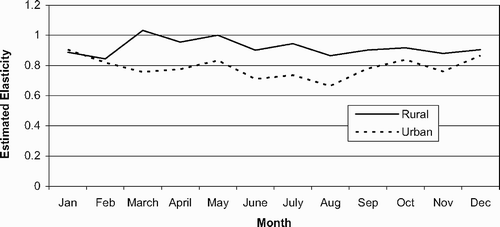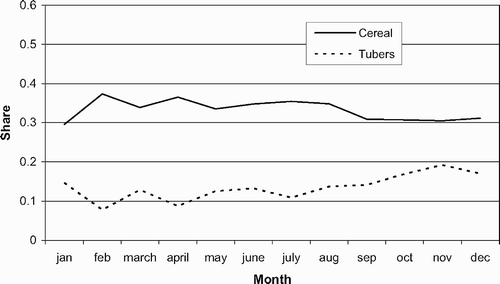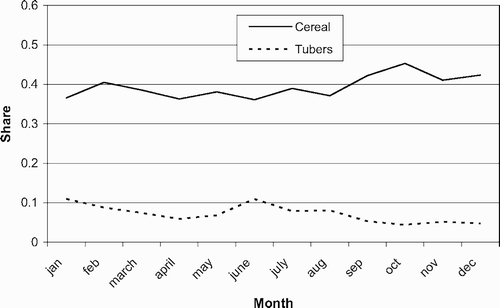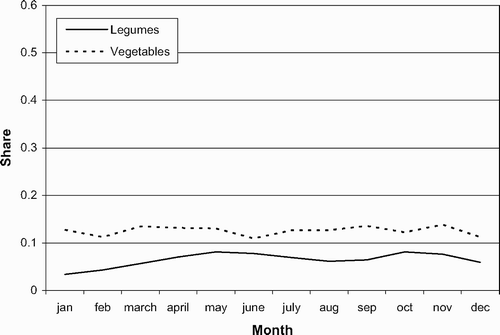Abstract
Seasonal fluctuations in food consumption are a serious problem in rural Mozambique, where community isolation is high, and market integration, use of improved inputs, and access to off-farm income are low. This article uses household survey data to trace seasonal fluctuations in food consumption patterns and to analyse the ways households maintain access to calories. Significant substitution is observed between maize and cassava, and beans and green vegetables, over the production cycle. An analysis of the total expenditure elasticity of food groups reveals how precarious food security is in rural households in the poorest quintile. These households show near unitary expenditure elasticity for even the most basic staples of maize and cassava. The potential role of public policy in diminishing seasonal fluctuation in food consumption is explored using distance to road as an indicator of market access. The results show that distance to the nearest road has a significant effect on household food consumption patterns.
1. INTRODUCTION
A significant problem in the quest for food security among poor agricultural households is sustaining food consumption during the lean season. This is especially true for farm households that rely on rainfed agriculture, and that have poor post-season storage capacity or limited market opportunities to make extra cash from post-harvest surpluses. A number of studies have documented the extent of consumption seasonality in developing countries, as well as the behavioural responses that agricultural households display in the face of extreme fluctuations in income due to the agricultural cycle [the articles in Sahn Citation(1989) provide an introduction to and overview of the issue of seasonality and its consequences among agricultural households in developing countries. Other studies that evaluate the extent and consequences of seasonality can be found in Paxson (Citation1992, Citation1993) and Alderman Citation(1996)].
This article explores some of these issues using the first national household survey of Mozambique where food security is a primary concern (Government of Mozambique, Citation1998). Over 80 per cent of Mozambique's 19 million people live in rural areas and depend on agriculture for their survival, yet only 3 per cent use improved agricultural inputs, and a similar percentage use non-rainfed sources of irrigation. While the country has experienced very high growth rates over the past eight years (averaging about 7 per cent per year), an overall GDP per capita of US$290 still places it among the poorest in the world, with about 78 per cent of the population living on or below $2 per day and 38 per cent on or below $1 per day. Given these conditions, and the geographic isolation of most rural communities, income seasonality and its implications are important policy issues in the country (Government of Mozambique, Citation2004, Citation2006), as they are in much of the smallholder sector in southern Africa.
The analysis in this article is divided into two parts. In the first part, we illustrate the seasonal variability in food consumption patterns of households, relating these to the agricultural production cycle and the typical diet in the country. Given this diet, we show how households substitute among food groups in order to maintain a balanced diet, and the key role that cassava plays in providing calories to households during the lean season. We also provide estimates of the income elasticity for staple and non-staple foods, which demonstrate the precarious food security position of rural households, especially those in the poorest quintile.
In the second part of the article, we evaluate the extent to which market access affects both food consumption patterns and the variability of food consumption over the agricultural cycle. We find that the food consumption patterns of households that we classify as having more market access differ markedly from those that have less access, in particular displaying less fluctuation in the consumption of staple foods. These results have important implications for rural area public policies whose objectives are to smooth consumption over the production cycle in order to reduce the risk of food insecurity during the lean season in rural Mozambique.
2. DATA
To plan and monitor policy impact on household food security and nutrition, it is necessary to understand the household food consumption patterns and forces that cause changes in these patterns. Because of the data limitations imposed by Mozambique's violent history, only a few previous studies have looked at food consumption patterns and behaviour in the country and these focus on specific geographical areas, usually provinces in the rural north or Maputo city (Dengo, Citation1992; Tschirley & Santos, Citation1994; Sahn & Desai, Citation1995; Rose et al., Citation1998).
2.1 The first national household survey
In 1996/97 a national household survey of Mozambique was conducted by the National Statistical Institute (Government of Mozambique, Citation1998). This survey, called the Inquerito Nacional Aos Agregados Familiares (IAF) is nationally representative, and was carried out over a 14-month period beginning in February 1996. The survey design was a three-stage stratified random sample, with rural/urban designating the strata, and the administrative unit known as the locality defining the primary sampling unit (our estimates of standard errors take into account correlations due to sampling design, and summary descriptive statistics are population-weighted so as to be representative of the country). We exploit the fact that the IAF was carried out over an entire year to identify seasonality effects in consumption. in the Appendix shows the number of households in each region that were interviewed in each month of the year (the total sample size is 8250 households). In the rural region the distribution of households over the 12 months is quite good, which helps us to identify seasonal affects over this cross section. In urban areas, however, most households were interviewed at the beginning of the year, so the representation of households is small between August and November. This means that our estimates of seasonality will be poorly measured for these months, which should be kept in mind in the proceeding analysis. Because of this potential weakness of the data, we concentrate most of our discussion on rural households, and also group households into three time periods so as to have enough observations in each period with which to make meaningful inferences.
In terms of information, the IAF is a standard multipurpose household survey with an extensive consumption expenditure module, as well as modules on health, education, agricultural production and migration. Total household welfare is measured by total household expenditure on consumption per capita, and this is normalised by a regional and seasonal price index so as to be comparable across households from different regions and interview months (technical details of the construction of the consumption aggregates and price indexes can be found in Government of Mozambique, Citation1998). Our analysis of consumption patterns is based on budget shares so that we avoid the problem of regional differences in the cost of living.
2.2 Description of expenditure seasonality
and provide some descriptive information about the degree and type of consumption seasonality found in Mozambique. shows the results of simple OLS regressions that relate total consumption, total food consumption and the food share to a set of monthly and provincial dummy variables. Wald tests for the joint significance of the monthly dummy variables, shown at the bottom of the table, give an idea of the importance of consumption fluctuations over the year among these households. In only one case are these monthly dummies not significant as a whole, and that is for total consumption in rural areas. This is probably because overall mean consumption is so low in rural Mozambique to begin with (mean per capita daily consumption was 50 US cents per day in rural areas at the time of the survey).
Table 1: OLS coefficient estimates of monthly dummy variables by region
Table 2: Staple food and total food shares, as percentage of total budget, by season (means)
presents mean shares out of total food consumption for the two basic staples of cereals and roots and tubers, as well as the most important subgroup within these two (maize and cassava). In Mozambique, as in most of southern Africa, the basic staple is maize, and the harvest season for maize begins in March and can last until May depending on how far north one is. Similarly, the sowing period begins in September and can last until November in some parts of the country. Hence the last trimester of the year (September–December) is the lean season, when stocks from the previous harvest begin to run low, and the end of the first trimester (January–April) and the second trimester (May–August) are ‘peak’ seasons, when stocks of maize are high and food insecurity low (this is a general characterisation that we make for analytical convenience and is meant to represent the average trend in the country; in specific areas, January and even part of February can be the tail end of the lean season). The behaviour of the maize share follows this cycle very closely. In rural areas, the share of maize as a proportion of the food budget is lowest during the lean season (0.198 in September to December), and increases steadily in trimesters 1 and 2. The behaviour of the cassava share is exactly opposite to this, as cassava is the ‘food security’ crop in this region of Africa, and is consumed in the lean season as a substitute for maize. The share of cassava in the food budget is highest in the lean season (trimester 3), and then declines steadily until it reaches a low of 0.114 in the second semester, when the maize share is highest.
In urban areas the pattern is slightly different owing to the importance of bread and wheat based products in the diet. For example, while the share of maize is lowest in the lean season, the total cereal share actually rises to 0.400 in trimester 3, primarily owing to the importance of imported wheat and wheat-based products in the diet. The overall food share, i.e. the share of food as a proportion of the total budget, actually fluctuates very little over these three trimesters in urban areas, whereas in rural areas there is a significant jump in the food share in the lean season, from 0.679 in trimester 2 to 0.702 in trimester 3.
We complete our descriptive analysis by presenting estimates of the total expenditure elasticity for food over the year. These are estimated by regressing log total expenditure on the log of total food expenditure, with seasonal differences calculated by allowing for dummy interactions between each of the 11 monthly dummies and the log total expenditure variable. These interaction terms are jointly significant, and the calculated elasticities are presented in in the Appendix, while the elasticity pattern is shown in for urban and rural regions separately. Urban areas are richer than rural ones in Mozambique, so their estimated food elasticity is accordingly lower. However, these elasticities come together at the height of the lean season (December and January). The rural food elasticities are very high, reaching 1 in March and May, indicating that virtually all additional income during this period is devoted to food purchases.
3. METHODOLOGY
This section outlines the method used to assess the effect of seasonality on food expenditure patterns. The principal analytical tool is the Engel curve, which relates budget shares devoted to various food groups to total household expenditures and other household characteristics such as demographic composition. The exact specification used is what is now commonly known as the Working–Leser functional form, for which applications can be found in Deaton and Muellbauer Citation(1980) and Handa Citation(1996), among others. This specification looks like the following:
Using Equationequation (1), the marginal effect on the budget share of a change in total household expenditure is given by Equationequation (2)
, while the total expenditure elasticity can be derived using the formula in Equationequation (3)
(Deaton et al., Citation1989):
4. RESULTS
4.1 Seasonality and consumption switching
Vegetables, beans, meat and fish are normally eaten together with a cereal (maize, rice and wheat derived products) or starch (cassava, sweet potatoes, Irish potatoes) as the main dish. It is therefore reasonable to assume that vegetables, beans, meats and fish are products that substitute for each other, and likewise cereals are substitutes for starchy foods and vice versa. The fact that production is seasonal, availability (supply) throughout the year will also influence consumption patterns over a year. This will be more pronounced when markets fail. Perishable seasonal products such as vegetables are expected to show higher seasonal fluctuations than cereals. Because rural household food expenditure is largely based on subsistence produce, local climatic conditions which affect yields over a year will have a marked effect on seasonal food consumption patterns. In addition, the cash income of such households is also seasonal since it is mainly derived from sales of surplus produce.
We estimate Equationequation (1) on eight broad food groups, by region: cereals, roots and tubers, meats, seafood, legumes, fruit, green vegetables, and other foods. We capture seasonality using monthly dummy variables (December is the excluded category), and results for these seasonality effects for cereals and roots and tubers are presented in in the Appendix. These show that the Wald test for joint significance of the seasonal variables is significant in all cases except for cereals in rural areas. and graph the predicted budget shares based on the regression coefficients for rural and urban areas respectively. In (rural), the cereal food share is highest in the first two trimesters and lowest in the last trimester (with the exception of January), while for roots and tubers the seasonality effect is exactly the opposite, as we would expect, with the share highest during the lean months in the last trimester of the year, and lowest in the other periods. Note that the curves almost always move in opposite directions, the budget share for tubers declining when that for cereals increases, and vice versa. This behaviour clearly indicates the substitution that takes place between these two food groups among Mozambican households.
Among urban households (), the overall share of cereals is much higher, and that of tubers lower, than in rural areas, but the same general picture of substitution between these two groups is revealed. The estimated share of cereals is highest in trimester 3, exactly when the estimated share of roots and tubers is lowest. Furthermore, the same ‘mirror’ image exists in the pattern of expenditures among urban households–the share of roots and tubers in the budget almost always moving in the opposite direction from the share of cereals.
In and in the Appendix we present the seasonality effect for the six other food groups that we consider. In rural areas, five of the six food groups display significant seasonality over the year (see joint test of significance at the bottom of ), with seafood being the only exception. In urban areas (), four of the six food groups display significant fluctuations over the year, the exceptions here being green vegetables and other foods (full results for all the control variables used in the Engel curve regression are available from the authors upon request). The degree of seasonal fluctuation among urban areas is surprising, given that incomes tend to be more stable and imported foods are available in the large urban centres in the south of the country (Maputo City, Matola and Xai-Xai).
In the light of our description of the typical Mozambican diet, we expect vegetables and beans to be substitutes in their role as accompaniments to maize (xima) or cassava, and so we evaluate this hypothesis in and , which graph the month coefficients presented in and . For rural areas (), the substitution between these two groups is quite evident, with the green vegetable share highest at the beginning of the year and lowest at the end of the year, and vice versa for legumes. In urban areas () the annual fluctuation is relatively smaller (recall that for vegetables the joint effects are not significant), but the basic pattern seems to be the same, with the legume share lowest at the beginning of the year and rising at the end of the year.
4.2 Total expenditure elasticity
We calculate and present the total expenditure elasticity by food group in for rural and urban areas, and separately by consumption quintile. An elasticity above 1 is usually considered a luxury, and below 1 a necessity. Using the magnitude of the elasticity as a measure of the degree of necessity, the degree of necessity for all rural households increases in the following order: maize (0.994), roots and tubers (0.833), green vegetables (0.827), cassava (0.817) and beans (0.656). Meats, other foods and seafood are estimated to be luxuries. The elasticity tends to be higher for households in the bottom quintile, although beans (legumes) are an exception, probably because these are more likely to be consumed out of home production for poor households. The striking thing is that for poor rural households, cereals and maize have an elasticity well over 1, indicating that these staples are still luxuries for the very poorest in rural areas. Even roots and tubers and cassava, which tend to be stored in the ground and used as crop insurance, have an elasticity close to 1. Taken together, these results demonstrate the extremely precarious food security situation faced by poor rural households in Mozambique.
Table 3: Total expenditure elasticity by quintile
The urban expenditure elasticity tends to be lower than the rural one, and for the sample as a whole only two commodity groups are estimated to be luxuries (meats and other foods). The elasticity for staple foods such as cereals and roots and tubers is well below 1, and is even lower among the richest quintile. Among the poorest urban quintile, meats and other foods are also clear luxuries, while roots, tubers and seafood have unitary elasticity.
Given that household food expenditure is largely based on subsistence production in rural areas, and that rural households are in general poorer than urban households, large differences are expected between urban and rural households in the degree of responsiveness of food consumption patterns to total expenditure. While the rural elasticity tends to be higher than the urban one, one important exception is meat, where the urban elasticity is higher than rural one for all quintiles shown. This is because rural meat consumption is essentially based on home production (including hunting), while urban households depend on market purchases for their meat.
4.2.1 Elasticity estimates by subregion
In Mozambique, market access and wellbeing tend to increase from north to south, so in we present the total expenditure elasticity by region to see if these regional characteristics result in different responses to changes in total expenditure or income (as with the description of the harvest and lean seasons, the characterisation of market access and integration as decreasing from south to north is simplistic. The border areas in the rural north engage in trade with Malawi, and Nampula is densely populated, with a major international port. On the other hand, parts of western Gaza in the south can be quite isolated). Given these characteristics, we would expect the elasticity to be higher in the north than in the south, although the degree of variation across zones might be smaller in rural than in urban areas. In fact the elasticity estimates presented in display this pattern with surprising consistency although there are a few exceptions. In the rural region, there is very little variation in the estimated elasticity as we move from north to south, and in some cases (total food, cereals, meat and vegetables) the estimated elasticity is actually slightly higher in the south, again because households in the north are more likely to consume these out of home produce.
Table 4: Total expenditure elasticity by region
In the urban areas, on the other hand, the elasticity tends to decline as we move from north to south, especially for the basic staples such as maize and cassava. The overall food elasticity (the first line in ) also declines significantly as we move from northern to southern Mozambique. Hence, it appears that market integration in terms of both access to imported foods and access to more stable sources of income can have an important effect on food consumption patterns, and ultimately on food security, in Mozambique. We provide a more detailed analysis of this hypothesis in the next section.
4.3 Market access and expenditure seasonality
The analysis above reveals that rural households face larger fluctuations in food consumption than urban ones, and there is significant variation in household response to income changes as we move from the more isolated north to the more integrated south of Mozambique. In this section we directly investigate the role that market access can play in seasonality of food consumption and, by doing so, seek to highlight the potential role for public policy in reducing food insecurity in the country. We have available to us the distance to the nearest road for each village in the IAF sample. This information was calculated by geographical information systems (GIS) based on geographical information provided by the Mozambican Directorate of Geography and Cadasters (DINAGECA), and details of these calculations are provided in Nhate Citation(1999). We use distance to nearest road as a rough indicator of access to markets and alternative sources of income, and hypothesise that increased market access may allow households to smooth consumption over the agricultural production cycle.
We focus on rural households only, and estimate separate Engel curves for the north, centre and south of the country. Because of sample size issues, we cannot include the full 11 monthly dummy variables, but rather capture seasonality by dividing interview dates into three groups: trimester 1 (January–April), trimester 2 (May–August) and trimester 3 (September–December). We use trimester 1 as the excluded category, and expect that seasonality in food budget shares will be strongest in the north, which is most isolated, and will diminish as we move towards the more integrated southern part of the country.
We experimented with several different approaches to measure the effect of distance to road on food on consumption patterns, including separate sample estimates and interaction terms. While interactions (between distance and the trimester dummies) allow for formal hypothesis tests, we end up with an enormous quantity of regression coefficients that are cumbersome to interpret. We therefore take a simpler approach and estimate a series of Engel curves on households located at different distances from a road. We estimate these regressions on six budget shares (maize, cassava, cereals, tubers, legumes and vegetables) for all rural households and for ten different distances, and focus on the difference in the budget share between trimester 1 (the excluded group) and trimester 3 (the lean season).
In addition to physical distance to a road, we also have direct evidence of alternative sources of income through the IAF employment module. Using that information, we construct a dummy variable indicating whether the household has any off-farm sources of income. However, unlike distance to road, this information on income source is endogenous to household decisions on food consumption, a problem that would normally require instrumental variables to correct. Nevertheless, we provide some provisional estimates of the association between the presence of an off-farm income source and fluctuations in food consumption patterns, hypothesising that these sources of income will serve to dampen the seasonal fluctuation in food consumption, although the precise cause and effect mechanism still remains to be clarified.
4.3.1 Distance to road
in the Appendix summarises the coefficient estimates for the dummy variable indicating trimester 3, for ten different subgroups of households, for the six commodities mentioned above. The distances we consider are: 0–2 km from a road, and then greater than 2, 3, 5, 6, 8, 12, 16, 20 and 24 km from the nearest road. Sample sizes for each of these subgroups are also presented in . The easiest way to assess the relationship between market access and seasonality is graphically, so we graph the point estimates for trimester 3 for each distance in , and . presents this relationship for the broad groups of cereals and tubers, and the results are startling. Both commodities display counter-cyclical patterns for households that live within 2 km of a road–the trimester 3 coefficient estimates are positive for cereal and negative for tubers (‘pro-cyclical’ means that cassava consumption increases during the lean season and maize consumption decreases; ‘counter-cyclical’ means that maize consumption actually increases during the lean season when maize is scarce). However, for households living more than 2 km from a road, there seems to be a strong positive relationship between fluctuation in the trimester 3 budget share and distance to a road. In the case of cereals, this relationship becomes flat after approximately 10 km, while for tubers the relationship flattens out sooner–at approximately 6 km.
Figure 6: Change in budget share (trimester 3 minus trimester 1) by distance to road for tubers and cereals
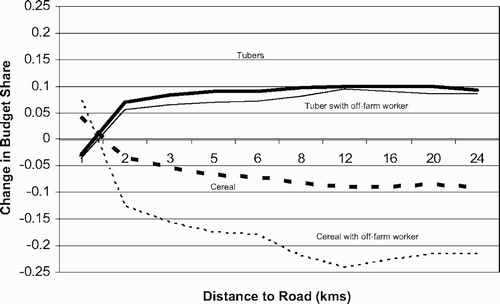
Figure 7: Change in budget share (trimester 3 minus trimester 1) by distance to road for cassava and maize
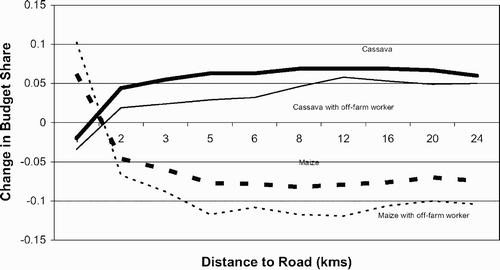
Figure 8: Change in budget share (trimester 3 minus trimester 1) by distance to road for beans and vegetables
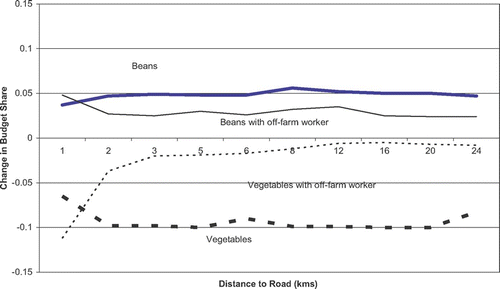
displays this relationship for maize and cassava budget shares, and the same general patterns emerges. Households within 2 km of a road display counter-cyclical consumption of these commodities, while households over 2 km from a road display the usual pattern of reduced maize share offset by increased cassava share during the lean season; note that the curves flatten out sooner than in , at around 5–6 km in both cases.
graphs the coefficients for legumes and vegetables, and here we see a weaker relationship between market access and fluctuations in trimester 3 budget shares relative to trimester 1. In both cases, there is a small initial jump between 0–2 km and greater than 2 km, but then the curves essentially flatten out, indicating that there is no further ‘penalty’ in terms of fluctuations in the budget share after 2 km.
4.3.2 Results for off-farm sources of income
We repeated the regressions described above on the subsample of households which indicated they had an off-farm source of income, to see whether this selected group of households displays less seasonal fluctuation in consumption over the year. In the same way as before, we graph the trimester 3 dummy variable for different groups of households based on their distance to a road, and expect to see a weaker relationship between distance and this coefficient than we observed over the full sample. For ease of comparison, these coefficients are also graphed in .
The results for tubers () and cassava () are as we expected. The subsample of households with an off-farm worker display less fluctuation in their trimester 3 consumption of these two commodities relative to the full sample (the lines for this group are closer to the x-axis relative to the line representing the full sample). However the opposite is found for cereal and maize consumption. In this latter case, the subsample of households with an off-farm worker actually display more fluctuation in trimester 3 relative to the sample as a whole (the line representing off-farm households lies outside the line representing the full sample for these two commodities). Indeed the differences in the trimester 3 coefficients are quite large. In the case of maize, for households 8 km or more from a road, the difference in the food budget shares is 0.10 percentage points.
We see from that this difference in cereal (and maize) consumption is entirely explained by different behaviour towards the consumption of green vegetables in trimester 3 by households with an off-farm worker. For these households, the budget share for green vegetables is nearly 0.10 percentage points greater than the full sample for households living over 8 km from a road. These results probably reflect the fact that off-farm employment and food consumption patterns are simultaneously determined. For example, rural households may be sacrificing their own farm maize production in exchange for off-farm sources of cash income, and using this income to compensate for maize shortages in the lean season through purchases of green vegetables (which are available at that time). Note, however, that households with off-farm income have fewer trimester 3 fluctuations in the budget share of legumes. A complete analysis of the full set of Engel curves for these households also indicates slightly higher consumption of meat during the lean season, relative to the full sample, which offsets the lower consumption of beans observed in (results available upon request).
5. CONCLUSIONS AND POLICY IMPLICATIONS
Our analysis of the food consumption behaviour of Mozambican households reveals some important patterns which can inform the country's agricultural development and food security strategy. Perhaps the most important initial observation is the high (nearly unitary) income elasticity for basic staple foods among poor (bottom quintile) rural households. For these households, even the most basic products such as cassava have unitary income elasticity, verifying what development agencies and government officials have also recognised, which is that the food security situation of this group is precarious.
Consistent with the low use of agricultural technology and market access, seasonal fluctuations in consumption are important, and closely follow the agricultural production cycle. Our analysis shows clear compensatory behaviour by households in an effort to equalise the consumption of calories over the production cycle, through increased consumption of cassava and other roots and tubers during the lean season when maize stocks are low. Significant substitution along the production cycle is also observed between legumes and vegetables, both important components of the typical diet, especially in the rural regions.
The Government of Mozambique has committed itself to a market-based development strategy, with market access through rural roads a particular pillar of emphasis in its new five-year agricultural sector plan (MADER, Citation2004). The results in this article support this policy, showing that increased market integration can lead to benefits in terms of reduced fluctuations in consumption over the agricultural season. Not only is seasonal fluctuation in the consumption of different food groups significantly higher in the more isolated northern region than in the more integrated centre or south; among rural households, access to markets, measured by distance to the nearest road, is strongly associated with reductions in pro-cyclical fluctuations in food consumption. For example, in the case of maize, households situated over 8 km from a road suffer a reduction in maize share in the lean season of almost ten percentage points, compared to five percentage points for households that live 2 km from a road; and households that live less than 2 km from a road actually display counter-cyclical fluctuation in maize share. Similarly, households at 10 km or more from a road display pro-cyclical fluctuations in their cassava food share of seven percentage points, while those living within 2 km of a road display counter-cyclical fluctuations in their cassava food share. These results indicate that infrastructure development projects aimed at increasing market access and integration for isolated rural households can have an important impact in reducing seasonal fluctuation in food consumption patterns in these areas, and support the country's current strategy as outlined in the PROAGRI II strategy document.
Finally, we provide some tentative results on the association between the existence of off-farm sources of income for the household, and seasonal fluctuation in food consumption patterns. We find that seasonal fluctuation in consumption behaviour is conditioned by the presence of an off-farm source of income in the household. In the case of basic foods such as cassava, vegetables and beans, households with off-farm employment display less seasonal variation in consumption over the year than those without an off-farm income source. In the case of maize, however, this group of households actually displays greater pro-cyclical consumption variation, which is supported by greater consumption of vegetables and meats during the lean season. This suggests that the overall diet of those households with an off-farm source of employment may be more balanced, but the cause and effect relationship between these two variables still requires further analysis.
Additional information
Notes on contributors
Gilead Mlay
Respectively, Associate Professor, Department of Public Policy, University of North Carolina; and Associate Professor, Faculty of Agronomy and Forestry Engineering, Eduardo Mondlane University, Maputo, Mozambique. The authors wish to thank Emilio Tostao, Farizana Omar, Virgolinho Nhate and Anibal Nhampossa for excellent research assistance, and David Tschirley for useful comments. All errors are the responsibility of the authors.REFERENCES
- Alderman , H . 1996 . Saving and economic shocks . Journal of Development Economics , 51 ( 2 ) : 343 – 65 .
- Deaton , A and Muellbauer , J . 1980 . Economics and consumer behavior , New York : Cambridge University Press .
- Deaton , A , Ruiz , J C and Thomas , D . 1989 . The influence of household composition on household expenditure patterns: theory and Spanish evidence . Journal of Political Economy , 97 : 179 – 200 .
- Dengo , M NC . 1992 . Household expenditure behavior and consumption growth linkages in rural Nampula Province , Michigan State University . MSc thesis
- Government of Mozambique . 1998 . Poverty and well-being: the first national assessment , Maputo, Mozambique : National Directorate of Planning and Development .
- Government of Mozambique . 2004 . Poverty and well-being: the second national assessment , Maputo, Mozambique : National Directorate of Planning and Development .
- Government of Mozambique . 2006 . Social and economic plan for 2006 , Maputo, Mozambique : National Directorate of Planning and Development .
- Handa , S . 1996 . Expenditure behavior and children's welfare: an analysis of female headed households in Jamaica . Journal of Development Economics , 50 : 165 – 87 .
- Ministerio de Agricultura e Desenvolvimento Rural (MADER) . 2004 . PROAGRI II strategy document , Maputo, Mozambique : MADER .
- Nhate , V . 1999 . Infraestructura, bem-estar familiar e pobreza em la zona rural em Moçambique , Maputo, Mozambique : Faculty of Agriculture and Forestry Engineering, Eduardo Mondlane University . Licenciatura thesis
- Paxson , C . 1992 . Using weather variability to estimate the response of savings to transitory income in Thailand . American Economic Review , 82 : 15 – 33 .
- Paxson , C . 1993 . Consumption and income seasonality in Thailand . Journal of Political Economy , 101 : 39 – 72 .
- Rose , D , Strasberg , P , Jeje , J and Tschirley , D . 1998 . Household food consumption in Mozambique: A case study in three northern districts , Vol. 33 , Ministry of Agriculture, Government of Mozambique . Research Report
- Sahn , D . 1989 . Seasonal variation in third world agriculture: the consequences for food security , Edited by: Sahn , D . Baltimore, MD : Johns Hopkins University Press for the International Food Policy Research Institute .
- Sahn , D and Desai , J . 1995 . The emergence of parallel markets in a transition economy: the case of Mozambique . Food Policy , 20 ( 2 ) : 83 – 98 .
- Tschirley , D and Santos , A P . 1994 . “ Who eats yellow maize: results of a survey of maize meal preferences in Maputo ” . Ministry of Agriculture, Government of Mozambique . Research Report 18
